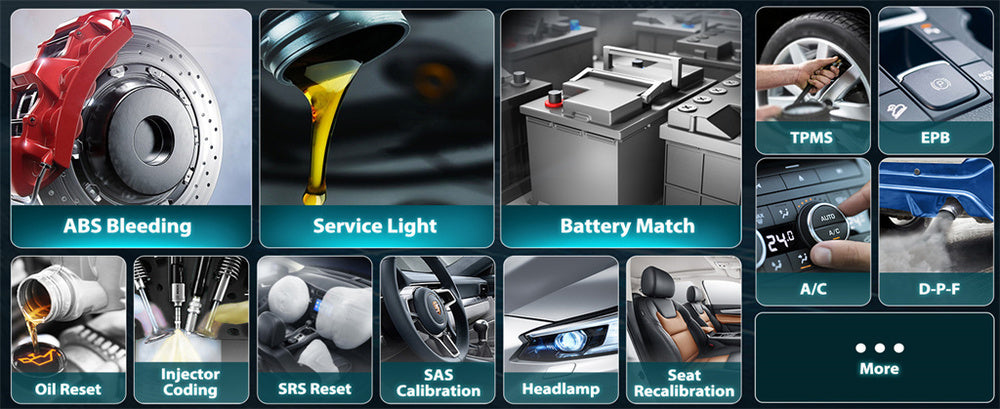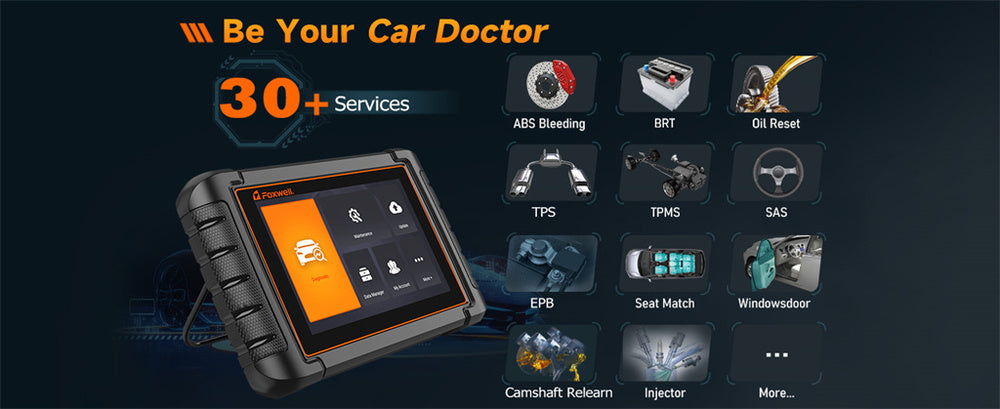Modern vehicles are engineering marvels featuring complex systems that maximize performance, safety, and convenience. Unfortunately, complexity also comes with malfunctions.
When warning lights appear on your dashboard as a telltale sign of trouble, it could indicate something more profound. Car scanners provide solutions by turning vague warning signals into actionable ones. In this article, I will share my experiences using car fault scanners and highlight their unique benefits.
Understand Symptom Alert Lights

Warning Lights of Your Car
Warning lights are the primary means your car communicates with you, providing notice of maintenance needs or system failure. Common indicators include check engine, ABS, and oil pressure lights, each signifying specific problems; without further details, it may be challenging to diagnose exactly where they arise.
Warning Light Limitations
While warning lights help provide early warning of potential problems, they need to give more details for diagnosis. A check engine light could mean anything from loose gas cap screws to serious engine malfunction. That is why car fault scanners become invaluable tools.
Car Fault Scanners and Their Importance
What Are Car Fault Scanners?
OBD2 scanners act like the stethoscope of automotive medicine. Just as doctors use theirs to listen to your heartbeat and diagnose health issues, an OBD scanner connects directly with the diagnostic port in your vehicle and communicates with its computer system; this interaction reveals its heartbeat by translating complex data into understandable diagnostic trouble codes (DTCs).
How Do Car Fault Scanners Work?
Suppose your engine control unit (ECU) continuously monitors various systems and components in your car. Any time something goes awry, it logs a trouble code with a warning light to signal its existence.
But these codes remain out of sight - acting much like secret messages waiting to be decoded - until an OBD scanner steps in as the decoding service for these messages stored within your engine control unit (ECU).
Scanning Process
- Connect the Scanner: Plug your scanner into the OBD-II port under your dashboard - this acts like a direct hotline to your vehicle's brain!
- Reading Trouble Codes: The scanner reads stored trouble codes once powered on. Each code serves as a clue to specific vehicle problems.
- Interpreting Data: Once the scanner has translated these codes into plain English, they indicate issues like a defective oxygen sensor, a misfire in one of the cylinders, or a problem with your catalytic converter.
Are there any methods I can use to take my car diagnostic tests?
With the rise of technology and the availability of diagnostic tools, DIY diagnostic testing has never been more accessible. No matter your experience level or car knowledge level, knowing how to diagnose vehicle issues yourself could save both time and money—but is this really possible? Let's investigate further.
What You Need To Begin To perform your car diagnostic test, a few essential tools will be required of you:
- OBD-II Scanner: This device is essential for reading diagnostic trouble codes (DTCs) stored on your car's computer system, from primary code readers to more sophisticated diagnostic tools. Various kinds are available, from primary code readers to comprehensive diagnostic solutions.
- User Manual: Obtaining an exhaustive guide for your specific scanner and vehicle diagnostic system will allow you to interpret codes correctly and data accurately.
- Smartphone or Computer: Some advanced OBD-II scanners boast wireless connectivity, enabling pairing with mobile apps or computer software for extensive diagnostics.
One highly recommended OBD-II scanner is the Foxwell NT909. Featuring an intuitive user interface, this scanner can accommodate beginners and more experienced users. Furthermore, its comprehensive diagnostic capabilities include reading and clearing trouble codes, providing real-time data, and special functions like oil reset and EPB service.
- Locating OBD-II Port: OBD-II ports are usually located underneath the dashboard near the driver's seat. If you need help finding one, consult your vehicle manual.
- Connect the OBD-II Scanner: Place the OBD-II scanner into its port before turning off your vehicle and connecting the scanner.
- Turn On Your Vehicle: Start your car to power the scanner. Follow its instructions to initiate diagnostic processes.
- Read and Keep Track of Trouble Codes: Your scanner can quickly retrieve and display any stored error codes, so note them for future reference.
- Interpret Codes: Use either your scanner's manual or an online database to interpret diagnostic trouble codes, which represent issues within your vehicle.
- Research and Plan: Once you understand the codes, research possible fixes. Establish whether the issue can be managed independently or requires professional intervention.
Advantages of DIY Diagnostics
- Cost Savings: Conducting your own diagnostics can save money over professional tests that may be more expensive. They provide immediate insight and save you time on service calls.
- Knowledge Is Power: Gaining knowledge about your vehicle enables you to make informed decisions regarding repairs and maintenance.
- Complex Issues: Complex issues often necessitate more advanced diagnostic tools and expertise beyond simple diagnosis.
- Safety Concerns: For safety concerns related to brakes or airbags, professional advice should always be sought from an automotive technician.
- Warranty Considerations: For newer vehicles under warranty, professional diagnostics and repairs may be necessary to maintain coverage under their coverage plan.
As an owner of multiple vehicles, I've discovered the benefits of car fault scanners as a must-have tool that makes vehicle maintenance much more straightforward and cost-efficient. Here's why:
Accurate Diagnostics
My car fault scanner has provided me with invaluable diagnostics. When warning lights came on before having one, they often caused stress about the cost and inconvenience of having to take my vehicle in for repairs - now, with my scanner, I can quickly check myself; for instance, when my check engine light went on last year, it turned out it was due to loose gas cap which required tightening it to solve my issue without incurring additional expenses or hassles.
An Automobile Fault Scanner Has Saved Me Money
Using an automotive fault scanner has helped me save money and time. Instead of paying for diagnostic tests at a garage, I can perform initial checks myself. One instance was when my car started running rough, and the scanner indicated a misfire in one cylinder.
Upon further inspection, it turned out to be due to a spark plug, which I quickly replaced myself for minimal cost. Even when I do need mechanic services later, knowing exactly the issue beforehand saves unnecessary repairs while reducing overall repair costs significantly.
Preventive Maintenance
Regular use of my car fault scanner has helped me spot potential problems early and address them before they escalate into more significant ones. For instance, during one routine scan,
I discovered an oxygen sensor issue even though the car seemed fine at the time—this preventive measure likely saved me from larger, more costly repairs in the future. Keeping an eye out for minor issues helps maintain the car's health and performance.
Fault Scanners Enhance Safety
Car fault scanners also contribute to increased safety. On one occasion, my ABS warning light came on while driving. Using my fault scanner, I discovered this was caused by a faulty ABS sensor and immediately had it replaced at my mechanic's shop to ensure proper braking system functioning. Knowing exactly what's wrong with my vehicle allows me to address safety concerns quickly for greater peace of mind.
Empowerment and Knowledge: One of the greatest joys of owning a car fault scanner is experiencing the sense of empowerment and knowledge it provides. I may not be an experienced mechanic, but being able to diagnose my car's issues makes me feel more in control.
I can speak more confidently with mechanics about needed repairs while making informed decisions without fearing overpaying or misinforming. It demystifies the process while eliminating the fear of being overcharged or misled.

Conclusion
Car fault scanners are indispensable tools in modern automotive maintenance. They save money on repairs and preventive maintenance and increase safety through accurate diagnostics. As DIY enthusiasts or those preferring professional service alike can appreciate, a car fault scanner is an invaluable investment that ensures their vehicle stays in excellent condition throughout their adventures.
As vehicle technology evolves, staying informed and equipped with the appropriate tools is vital to maintaining your car's health. When warning lights appear on the dash, take the initiative and use your scanner to tackle them instead of shrugging in disbelief!
FAQs:
How do car fault scanners work?
Car fault scanners connect to the vehicle's OBD2 port to read diagnostic trouble codes and identify issues.
Can a car fault scanner clear warning lights?
Yes, after diagnosing and fixing the problem, a car fault scanner can clear the warning lights.
Are car fault scanners easy to use?
Most car fault scanners are user-friendly, providing clear instructions for reading and interpreting codes.




Leave a comment
This site is protected by hCaptcha and the hCaptcha Privacy Policy and Terms of Service apply.